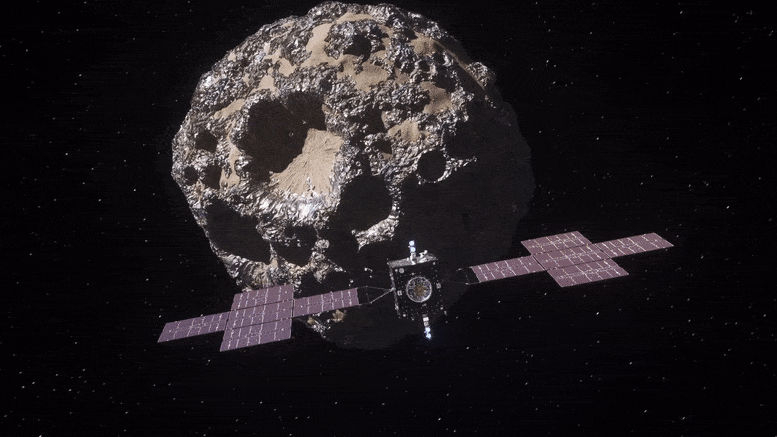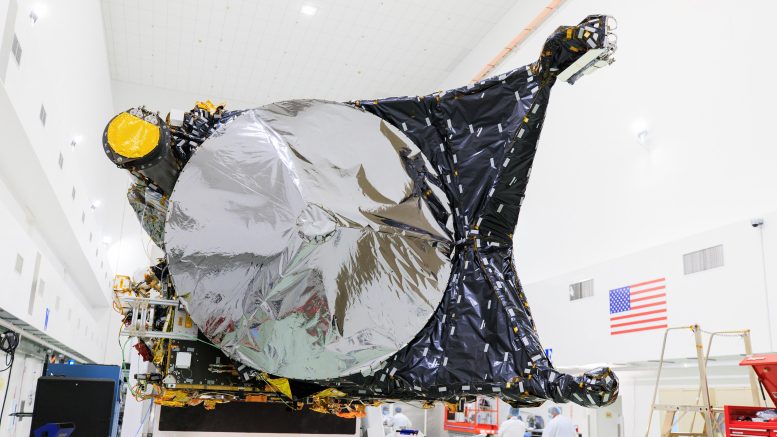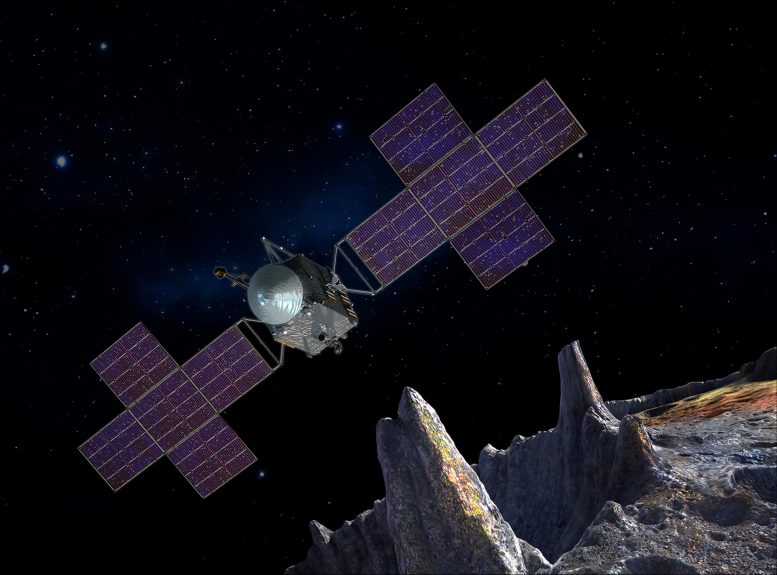
NASA’s Psyche mission will explore a unique metallic asteroid orbiting the sun between Mars and Jupiter. The asteroid, likely made largely of nickel-iron metal mixed with rock, could contain metal from the core of a planetesimal (the building block of an early rocky planet) and may offer a unique window into the violent history of collisions and accretion that created the terrestrial planets like Earth. Credit: NASA
Engineers and technicians at Cape Canaveral are preparing the Psyche spacecraft for liftoff, which is slated for October 5.
With less than 100 days remaining before its October 5 launch, NASA’s Psyche spacecraft is undergoing final preparations at Cape Canaveral, Florida. Teams of engineers and technicians are working diligently, essentially around the clock, to ensure the orbiter is ready to journey 2.5 billion miles (4 billion kilometers) to a metal-rich asteroid that may tell us more about planetary cores and how planets form.
The mission team recently completed a comprehensive test campaign of the flight software and installed it on the spacecraft, clearing the hurdle that kept Psyche from making its original 2022 launch date.
NASA’s Psyche spacecraft is shown in a clean room on June 26 at the Astrotech Space Operations facility near the agency’s Kennedy Space Center in Florida. Credit: NASA/Frank Michaux
Team Anticipation and Rocket Details
“The team and I are now counting down the days to launch,” said Henry Stone, Psyche’s project manager at NASA’s Jet Propulsion Laboratory in Southern California. “Our focus has shifted to safely completing the final mechanical closeout of the spacecraft and preparing the team for operations. The team is conducting numerous training activities to ensure that we are prepared and ready. It’s a very busy time, but everyone is very excited and looking forward to the launch.”
Psyche is set to launch atop a SpaceX Falcon Heavy (the first interplanetary launch for that rocket) from Space Launch Complex 39A at Kennedy Space Center at 10:38 a.m. EDT (7:38 a.m. PDT) on October 5, with additional opportunities scheduled through October 25. After escaping Earth’s gravity, the Psyche spacecraft will use solar electric propulsion to accomplish its six-year journey to asteroid Psyche.
Learn more about NASA’s Psyche mission to a metal-rich asteroid from the people who are leading the science investigation and the engineering that will make it happen. Credit: NASA/JPL-Caltech
Asteroid Psyche and Its Potential Significance
Measuring about 173 miles (279 kilometers) at its widest point, the asteroid Psyche presents a unique opportunity to explore a metal-rich body that may be part of a core of a planetesimal, the building block of an early planet. Once the spacecraft reaches Psyche in the main asteroid belt between Mars and Jupiter, it will spend at least 26 months orbiting the asteroid, gathering images and other data that will tell scientists more about its history and what it is made of.
The high gain antenna of NASA’s Psyche spacecraft takes center stage in this photo, captured at the Astrotech Space Operations facility near the agency’s Kennedy Space Center in Florida. Credit: NASA/Frank Michaux
Next Steps
However, before this can occur, a team of approximately 30 engineers and technicians need to complete the assembly, testing, and launch operations phase of the mission. Recent weeks have seen successful functional tests of the scientific instruments, spacecraft hardware, and software.
After removing the last of the cables that snake around the hardware for testing, they’ll “close out” the spacecraft by reinstalling some exterior panels that had been removed for access and complete the thermal blanketing. Later in July, they will integrate and test the deployment of the gigantic solar arrays. Then, in mid-August, a crew will begin slowly loading all 2,392 pounds (1,085 kilograms) of propellant – the neutral gas xenon – onto the spacecraft over the course of a couple weeks.
NASA’s Psyche mission to a distant metal asteroid will carry a revolutionary Deep Space Optical Communications (DSOC) package. This artist’s concept shows Psyche spacecraft with a five-panel array. Credit: NASA/JPL-Caltech/Arizona State Univ./Space Systems Loral/Peter Rubin
Team Confidence
Luis Dominguez, the systems and electrical lead for assembly, test, and launch operations, is usually based at JPL but has been working full-time at the Cape since early June. “We are moving forward,” he said, “and we’re confident that when we’re on the pad, we’ll be ready to hit the button. For all of us, we’ll be excited to launch this bird.”
More About the Mission
The Psyche mission is led by Arizona State University, with Jet Propulsion Laboratory (JPL), a division of Caltech in Pasadena, managing overall mission aspects including system engineering, integration, test, and mission operations. Maxar Technologies in Palo Alto, California, provided the high-power solar electric propulsion spacecraft chassis.
In addition to the main mission, JPL is providing a technology demonstration instrument, Deep Space Optical Communications. This instrument, set to fly on Psyche, will test high-data-rate laser communications that could be employed by future NASA missions.
This is the 14th mission selected as part of NASA’s Discovery Program, which is managed by the agency’s Marshall Space Flight Center in Huntsville, Alabama.
>>> Read full article>>>
Copyright for syndicated content belongs to the linked Source : SciTechDaily – https://scitechdaily.com/destination-psyche-nasa-spacecraft-prepares-for-epic-2-5-billion-mile-voyage/


































